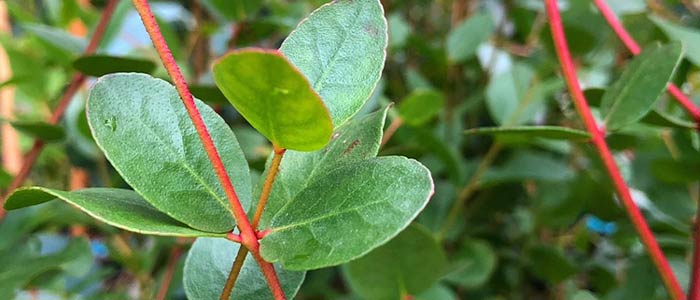- Shop
- Apparel
- Berries
- Books
- Bundles
- Citrus
- Fertilizer & Pest Control
- Fruiting Ground Covers
- Fruiting Shrubs
- Fruiting Trees
- Herbs, Spices, and Teas
- Mason Bees
- Nitrogen Fixers and Companion Plants
- Northwest Natives
- Nut Trees
- Ornamentals & More
- Perennial Vegetables
- Rootstock
- Subtropical Fruits
- Tools
- Vines
- Xeriscape
- Sale Items
- Information
- Nursery News
- Contact Us
- My Account

Elevate Your Landscape with Eucalyptus Trees!
There are few trees that have such an instant impact in the garden as a eucalyptus. Being well adapted to growing in Australian soils much lower in many nutrients than ours here, they grow at a startlingly fast rate, especially during their first few years in the ground, and have some of the most ornamental foliage of any plant we might grow here.
Eucalyptus is a genus that has fascinated us since childhood, but it was only once we needed a tall hedge as quickly and cheaply as possible that we really took the deep dive into growing them and learning about all the cold hardy varieties that grow in the Pacific Northwest. While many Australian natives are just slightly too tender for us to grow here, (cue the list of Grevillea, Banksia, Hakea, Melaleuca, Acacia, etc. that we so wish we could grow!), there are many Eucalyptus species from high elevations in Tasmania and other parts of Southern Australia that, with the proper siting and care, will thrive for us here in the Pacific Northwest and other USDA Zone 7-10 climates around the country.
Though quite easy to grow once you get them established, there are a few rules to follow if you’re to have success growing Eucalyptus trees here.
Eucalyptus Planting Tips:
1. Plant them when they’re small and not terribly root bound. Circling roots or a plant that has become stunted in a pot will often grow for a few years, only to have a root system that can’t support it and then start tipping in winter winds.
2. Plant in full sun and well draining soil! Though there are a few species we grow that come from some swampier parts of Australia, most Eucalyptus species prefer a very well draining, low nutrient mineral soil in full sun to be at their healthiest. Adding fertilizer is a big no-no as these trees will already grow at a lightning fast rate without any additional nitrogen being added to the soil.
3. Stake them only when they’re very young so they can establish a strong trunk. Most eucalyptus trees have a mind of their own and will grow in whatever direction they choose. Sometimes you’ll have ones that grow straight up and other times they’ll take on a severe lean. Consider yourself lucky if you have a straight grower. Trees that lean too much often need to be coppiced and allowed to regrow their trunk in a straighter manner. Just be sure you have a species that resprouts after coppicing. If you have one of the snow gums, or pauciflora varieties, they will not coppice after being cut and a leaning tree might need to be replaced entirely.
4. Get them as established as possible the first summer! Deep waterings once a week will cause explosive growth and quickly create a plant that is quite woody. Going into winter with a nice thick trunk greatly increases the chances of survival, and those first couple of winters can make or break a young eucalyptus.
5. Cut off all summer water after the first year and dry them off in late summer. Eucalyptus are supremely drought tolerant for the most part and will require very little to no summer water depending on their provenance once they are established. Excessive summer water can lead to lanky growth and too much late season growth that can potentially cause winter damage.
6. Don’t be afraid to prune them! A balanced tree is crucial, and this can sometimes mean balancing the top growth with the root growth. Trees growing too much in one direction can be trimmed to balance them out, and as a bonus, you’ll have more wreath and bouquet materials than you could have ever dreamt of after a good pruning!
7. Don’t plant them in a fire prone area! Eucalyptus have oils in their leaves, the same oils that make them so very fragrant, that are often incredibly flammable. Though many of these species are fire adapted, they can also be a fire hazard in rural areas that are at risk of wildfires. In the concrete coated city you have nothing to worry about but right next to your home or barn in rural and wilder areas might not be a great idea.
8. If you’re planning on growing your eucalyptus trees for the ornamental foliage you often see in floral arrangements, you’ll need to coppice it back regularly to maintain the juvenile growth. Do not coppice eucalyptus trees until late spring in the second or third year after planting to ensure that they are well-established and can handle being cut back. If left to grow to a full size tree they will eventually create mostly adult foliage, usually sickle shaped, with a handful of shoots that maintain the juvenile foliage.
